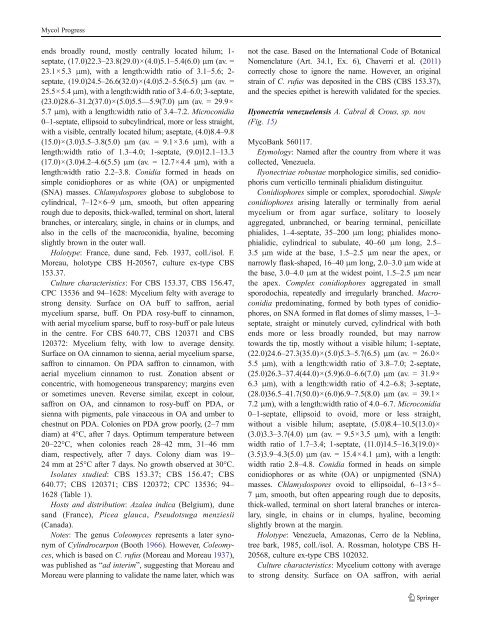Cylindrocarpon root rot: multi-gene analysis reveals novel ... - CBS
Cylindrocarpon root rot: multi-gene analysis reveals novel ... - CBS
Cylindrocarpon root rot: multi-gene analysis reveals novel ... - CBS
You also want an ePaper? Increase the reach of your titles
YUMPU automatically turns print PDFs into web optimized ePapers that Google loves.
Mycol Progressends broadly round, mostly centrally located hilum; 1-septate, (17.0)22.3–23.8(29.0)×(4.0)5.1–5.4(6.0) μm (av. =23.1×5.3 μm), with a length:width ratio of 3.1–5.6; 2-septate, (19.0)24.5–26.6(32.0)×(4.0)5.2–5.5(6.5) μm (av.=25.5×5.4 μm), with a length:width ratio of 3.4–6.0; 3-septate,(23.0)28.6–31.2(37.0)×(5.0)5.5––5.9(7.0) μm (av. = 29.9×5.7 μm), with a length:width ratio of 3.4–7.2. Microconidia0–1-septate, ellipsoid to subcylindrical, more or less straight,with a visible, centrally located hilum; aseptate, (4.0)8.4–9.8(15.0)×(3.0)3.5–3.8(5.0) μm (av. = 9.1×3.6 μm), with alength:width ratio of 1.3–4.0; 1-septate, (9.0)12.1–13.3(17.0)×(3.0)4.2–4.6(5.5) μm (av. = 12.7×4.4 μm), with alength:width ratio 2.2–3.8. Conidia formed in heads onsimple conidiophores or as white (OA) or unpigmented(SNA) masses. Chlamydospores globose to subglobose tocylindrical, 7–12×6–9 μm, smooth, but often appearingrough due to deposits, thick-walled, terminal on short, lateralbranches, or intercalary, single, in chains or in clumps, andalso in the cells of the macroconidia, hyaline, becomingslightly brown in the outer wall.Holotype: France, dune sand, Feb. 1937, coll./isol. F.Moreau, holotype <strong>CBS</strong> H-20567, culture ex-type <strong>CBS</strong>153.37.Culture characteristics: For <strong>CBS</strong> 153.37, <strong>CBS</strong> 156.47,CPC 13536 and 94–1628: Mycelium felty with average tostrong density. Surface on OA buff to saffron, aerialmycelium sparse, buff. On PDA rosy-buff to cinnamon,with aerial mycelium sparse, buff to rosy-buff or pale luteusin the centre. For <strong>CBS</strong> 640.77, <strong>CBS</strong> 120371 and <strong>CBS</strong>120372: Mycelium felty, with low to average density.Surface on OA cinnamon to sienna, aerial mycelium sparse,saffron to cinnamon. On PDA saffron to cinnamon, withaerial mycelium cinnamon to rust. Zonation absent orconcentric, with homo<strong>gene</strong>ous transparency; margins evenor sometimes uneven. Reverse similar, except in colour,saffron on OA, and cinnamon to rosy-buff on PDA, orsienna with pigments, pale vinaceous in OA and umber tochestnut on PDA. Colonies on PDA grow poorly, (2–7 mmdiam) at 4°C, after 7 days. Optimum temperature between20–22°C, when colonies reach 28–42 mm, 31–46 mmdiam, respectively, after 7 days. Colony diam was 19–24 mm at 25°C after 7 days. No growth observed at 30°C.Isolates studied: <strong>CBS</strong> 153.37; <strong>CBS</strong> 156.47; <strong>CBS</strong>640.77; <strong>CBS</strong> 120371; <strong>CBS</strong> 120372; CPC 13536; 94–1628 (Table 1).Hosts and distribution: Azalea indica (Belgium), dunesand (France), Picea glauca, Pseudotsuga menziesii(Canada).Notes: The genus Coleomyces represents a later synonymof <strong>Cylindrocarpon</strong> (Booth 1966). However, Coleomyces,which is based on C. rufus (Moreau and Moreau 1937),was published as “ad interim”, suggesting that Moreau andMoreau were planning to validate the name later, which wasnot the case. Based on the International Code of BotanicalNomenclature (Art. 34.1, Ex. 6), Chaverri et al. (2011)correctly chose to ignore the name. However, an originalstrain of C. rufus was deposited in the <strong>CBS</strong> (<strong>CBS</strong> 153.37),and the species epithet is herewith validated for the species.Ilyonectria venezuelensis A. Cabral & Crous, sp. nov.(Fig. 15)MycoBank 560117.Etymology: Named after the country from where it wascollected, Venezuela.Ilyonectriae robustae morphologice similis, sed conidiophoriscum verticillo terminali phialidum distinguitur.Conidiophores simple or complex, sporodochial. Simpleconidiophores arising laterally or terminally from aerialmycelium or from agar surface, solitary to looselyaggregated, unbranched, or bearing terminal, penicillatephialides, 1–4-septate, 35–200 μm long; phialides monophialidic,cylindrical to subulate, 40–60 μm long, 2.5–3.5 μm wide at the base, 1.5–2.5 μm near the apex, ornarrowly flask-shaped, 16–40 μm long, 2.0–3.0 μm wide atthe base, 3.0–4.0 μm at the widest point, 1.5–2.5 μm nearthe apex. Complex conidiophores aggregated in smallsporodochia, repeatedly and irregularly branched. Macroconidiapredominating, formed by both types of conidiophores,on SNA formed in flat domes of slimy masses, 1–3-septate, straight or minutely curved, cylindrical with bothends more or less broadly rounded, but may narrowtowards the tip, mostly without a visible hilum; 1-septate,(22.0)24.6–27.3(35.0)×(5.0)5.3–5.7(6.5) μm (av. = 26.0×5.5 μm), with a length:width ratio of 3.8–7.0; 2-septate,(25.0)26.3–37.4(44.0)×(5.9)6.0–6.6(7.0) μm (av. = 31.9×6.3 μm), with a length:width ratio of 4.2–6.8; 3-septate,(28.0)36.5–41.7(50.0)×(6.0)6.9–7.5(8.0) μm (av. = 39.1×7.2 μm), with a length:width ratio of 4.0–6.7. Microconidia0–1-septate, ellipsoid to ovoid, more or less straight,without a visible hilum; aseptate, (5.0)8.4–10.5(13.0)×(3.0)3.3–3.7(4.0) μm (av. = 9.5×3.5 μm), with a length:width ratio of 1.7–3.4; 1-septate, (11.0)14.5–16.3(19.0)×(3.5)3.9–4.3(5.0) μm (av. = 15.4×4.1 μm), with a length:width ratio 2.8–4.8. Conidia formed in heads on simpleconidiophores or as white (OA) or unpigmented (SNA)masses. Chlamydospores ovoid to ellipsoidal, 6–13×5–7 μm, smooth, but often appearing rough due to deposits,thick-walled, terminal on short lateral branches or intercalary,single, in chains or in clumps, hyaline, becomingslightly brown at the margin.Holotype: Venezuela, Amazonas, Cerro de la Neblina,tree bark, 1985, coll./isol. A. Rossman, holotype <strong>CBS</strong> H-20568, culture ex-type <strong>CBS</strong> 102032.Culture characteristics: Mycelium cottony with averageto strong density. Surface on OA saffron, with aerial
















